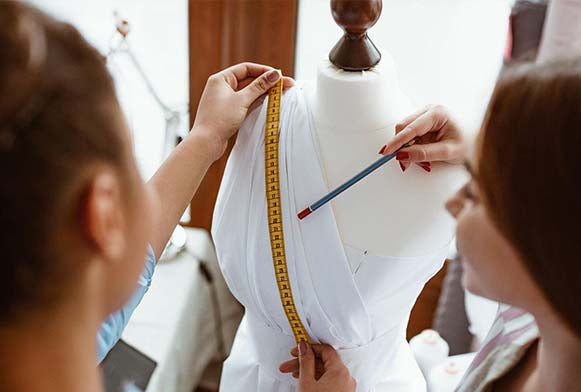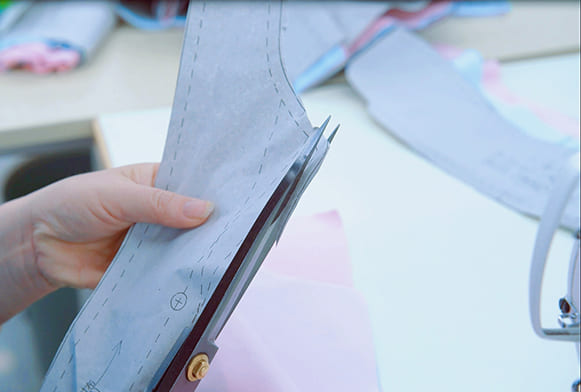Seacell Fabrics Pajamas That Emit Far Infrared Rays And Generate Negative Ions

Definition of seaweed fabrics
Seacell fabrics is a kind of man-made fabrics, which refers to the fabrics made from alginate extracted from some brown algae plants in the ocean. At present, there are many classifications of seaweed fabrics, which can be divided according to product use, polysaccharide type, fabrics composition, etc.
Seacell fabrics morphology
Seaweed fabrics is uniform in thickness and has grooves on the longitudinal surface. The cross section is irregularly serrated and has no thick cortex. It is similar to the cross section of ordinary viscose fabrics. The microscopic morphology of the fabrics mainly depends on the coagulation conditions. A large amount of solvent must be removed during the solidification molding process, causing the fabrics cross section to shrink and become irregularly serrated.
Seacell fabrics properties
It has the properties of rapid hemostasis and human body absorbability. Seaweed fabrics has brought revolutionary changes to the development of new materials. The previous fabrics materials came from land and oil. The birth of seaweed fabrics has opened up a third source of new materials.
Application
Research on seacell fabrics
The ocean is a treasure trove of resources and a strategic location for high-quality development. Qingdao, China, was born and prospered by the sea. Here, the sea is the "cotton warehouse" of the future, and kelp can be made into clothes. Enter the "National Key Laboratory of Biopolysaccharide fabrics Forming and Ecological Textiles" of Qingdao University to see what kind of "black technology" this is.
Qingdao University has disclosed a patent for a chitosan-grafted seaweed fabrics and its preparation method and use. This fabrics has good hygroscopicity and antibacterial properties due to the surface coating of a certain amount of chitosan, and is non-toxic, harmless, highly safe and biodegradable. It has good application prospects in the fields of medicine and environmental protection. As a new material for hemostasis treatment, it is particularly suitable for making gauze for wound dressing. fabrics strength: 1.5d~2.5d. Elongation at break: 4%~10%. Breaking strength: 1.8g/d~3.1g/d. Qingdao University has carried out school-enterprise cooperation and successfully overcome the technical barriers of seaweed fabrics that is not easy to dye. Its dyeing technology has obtained a national invention patent, and it has presided over the formulation of the "Seacell fabrics Blended Knitted Clothing" industry standard, becoming the first domestic company to use seaweed fabrics in knitted clothing. At present, seaweed fabrics can not only be used as a fireproof material in firefighting uniforms, but can also be made into ready-made clothes after dyeing. Qingdao now has the world's largest seaweed fabrics production line for textiles and clothing, with an annual production capacity of 5,000 tons.
About seacell fabrics projects
On August 15, 2024, the China Yantai Forum on Carbon Peak and Carbon Neutrality kicked off, and 24 new quality productivity projects were signed to promote the green, low-carbon and high-quality development of the economy and society. Speaking of the future planning of the project, the Textile Technology Group said: The implementation of the purpose will contribute to the acceleration of the construction of Yantai's green manufacturing system and the upgrading and development of the upstream and downstream industrial chains, and contribute to the "Huigao Power". "The project we signed is the Yantai Marine Biomaterials Project. Seaweed fabrics is a plant fabrics from the ocean. It is a substitute for traditional fabricss and is mainly used in functional textiles, biomedicine, medical beauty and health, smart wearables, military and aerospace, etc. We select seedlings, carry out three-dimensional marine farming, and "plant trees" in the sea to solve the "resource crisis" and environmental pollution problems of land and petrochemicals. It not only purifies the water quality of the sea area and increases the carbon sink capacity of the ocean, but also promotes the cultivation and application of seaweed upwards and promotes the upgrading of the entire seaweed fabrics industry chain downwards.
About the future
Seaweed carbon fabrics and seacell fabrics are not made of ore but are natural plant materials. The raw materials are made of raw materials, and the waste can be biodegraded and returned to nature without polluting the environment. Seaweed carbon fabrics has the effect of far infrared radiation and negative ion generation. Seaweed fabrics has moisturizing and mineral calcium and magnesium components that have a natural beauty effect on the skin. Driven by the continuous progress of current biochemical technology, if these fabricss with heat preservation, health care and beauty functions can be combined with practical applications and popular fashion, color, style and other designs, they will be able to gain the favor and use of consumers, conform to the further promotion of health and environmental protection concepts, and believe that in the near future people's lives will have a closer connection with this unique fabrics.
Seacell fabrics is a kind of man-made fabrics, which refers to the fabrics made from alginate extracted from some brown algae plants in the ocean. At present, there are many classifications of seaweed fabrics, which can be divided according to product use, polysaccharide type, fabrics composition, etc.
Seacell fabrics morphology
Seaweed fabrics is uniform in thickness and has grooves on the longitudinal surface. The cross section is irregularly serrated and has no thick cortex. It is similar to the cross section of ordinary viscose fabrics. The microscopic morphology of the fabrics mainly depends on the coagulation conditions. A large amount of solvent must be removed during the solidification molding process, causing the fabrics cross section to shrink and become irregularly serrated.
Seacell fabrics properties
- Mechanical properties
- Hygroscopicity
- Flame retardancy
- Far infrared radiation function
It has the properties of rapid hemostasis and human body absorbability. Seaweed fabrics has brought revolutionary changes to the development of new materials. The previous fabrics materials came from land and oil. The birth of seaweed fabrics has opened up a third source of new materials.
- Electromagnetic shielding & antistatic ability
- Gel blocking property
- Biodegradability & Compatibility
- Antibacterial property
- Anti-radiation property
Application
- Textile and clothing
- Medical use
- Sanitary care applications
Research on seacell fabrics
The ocean is a treasure trove of resources and a strategic location for high-quality development. Qingdao, China, was born and prospered by the sea. Here, the sea is the "cotton warehouse" of the future, and kelp can be made into clothes. Enter the "National Key Laboratory of Biopolysaccharide fabrics Forming and Ecological Textiles" of Qingdao University to see what kind of "black technology" this is.
Qingdao University has disclosed a patent for a chitosan-grafted seaweed fabrics and its preparation method and use. This fabrics has good hygroscopicity and antibacterial properties due to the surface coating of a certain amount of chitosan, and is non-toxic, harmless, highly safe and biodegradable. It has good application prospects in the fields of medicine and environmental protection. As a new material for hemostasis treatment, it is particularly suitable for making gauze for wound dressing. fabrics strength: 1.5d~2.5d. Elongation at break: 4%~10%. Breaking strength: 1.8g/d~3.1g/d. Qingdao University has carried out school-enterprise cooperation and successfully overcome the technical barriers of seaweed fabrics that is not easy to dye. Its dyeing technology has obtained a national invention patent, and it has presided over the formulation of the "Seacell fabrics Blended Knitted Clothing" industry standard, becoming the first domestic company to use seaweed fabrics in knitted clothing. At present, seaweed fabrics can not only be used as a fireproof material in firefighting uniforms, but can also be made into ready-made clothes after dyeing. Qingdao now has the world's largest seaweed fabrics production line for textiles and clothing, with an annual production capacity of 5,000 tons.
About seacell fabrics projects
On August 15, 2024, the China Yantai Forum on Carbon Peak and Carbon Neutrality kicked off, and 24 new quality productivity projects were signed to promote the green, low-carbon and high-quality development of the economy and society. Speaking of the future planning of the project, the Textile Technology Group said: The implementation of the purpose will contribute to the acceleration of the construction of Yantai's green manufacturing system and the upgrading and development of the upstream and downstream industrial chains, and contribute to the "Huigao Power". "The project we signed is the Yantai Marine Biomaterials Project. Seaweed fabrics is a plant fabrics from the ocean. It is a substitute for traditional fabricss and is mainly used in functional textiles, biomedicine, medical beauty and health, smart wearables, military and aerospace, etc. We select seedlings, carry out three-dimensional marine farming, and "plant trees" in the sea to solve the "resource crisis" and environmental pollution problems of land and petrochemicals. It not only purifies the water quality of the sea area and increases the carbon sink capacity of the ocean, but also promotes the cultivation and application of seaweed upwards and promotes the upgrading of the entire seaweed fabrics industry chain downwards.
About the future
Seaweed carbon fabrics and seacell fabrics are not made of ore but are natural plant materials. The raw materials are made of raw materials, and the waste can be biodegraded and returned to nature without polluting the environment. Seaweed carbon fabrics has the effect of far infrared radiation and negative ion generation. Seaweed fabrics has moisturizing and mineral calcium and magnesium components that have a natural beauty effect on the skin. Driven by the continuous progress of current biochemical technology, if these fabricss with heat preservation, health care and beauty functions can be combined with practical applications and popular fashion, color, style and other designs, they will be able to gain the favor and use of consumers, conform to the further promotion of health and environmental protection concepts, and believe that in the near future people's lives will have a closer connection with this unique fabrics.





Leave a comment